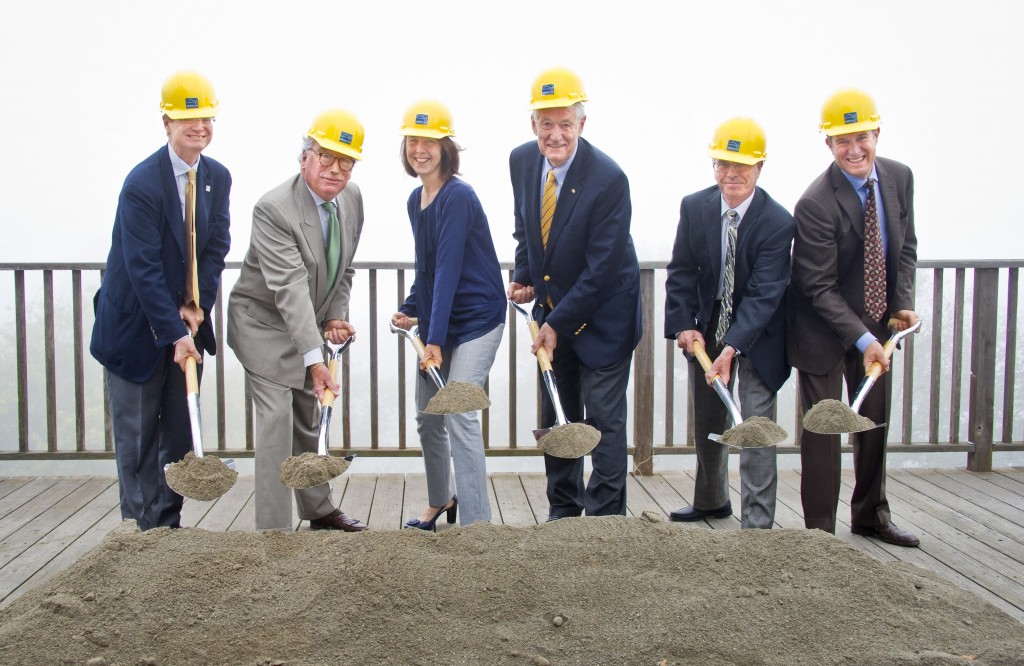Berkeley, Calif., Oct. 19, 2012—Efforts to find alternative fuels from sunlight will be getting some needed help soon as Lawrence Berkeley National Laboratory (Berkeley Lab) broke ground on its latest research facility, the Solar Energy Research Center (SERC). The three-story structure will be nearly 40,000 sq. ft. in size and will house approximately 75 people.
The $54 million project is slated to be completed in late 2014.
SERC will house research laboratories and offices of the Joint Center for Artificial Photosynthesis (JCAP), devoted to fundamental research and technology development of a solar fuel generator. These will include methods for synthesizing new light absorbing materials, catalysts for fuel generation, separation membranes, and assembly methods to build a complete integrated system. The goal is to develop prototype artificial photosystems capable of robustly producing a fuel from sunlight ten times more efficient than current crops, only using non-arable land.

Digging in at the ceremonial SERC groundbreaking event were (l-r): Berkeley Lab Director Paul Alivisatos, CPUC President Michael Peevey, Assemblymember Nancy Skinner (D-Berkeley), UC Berkeley Chancellor Robert Birgeneau, Berkeley Lab JCAP Director Heinz Frei, and Nat Simons from the Simons Foundation.
“JCAP will allow us to develop the science and technology needed to create future transportation fuels from sunlight,” says Berkeley Lab Director Paul Alivisatos. “Our country has a real need for alternatives to the fuels we use now and we’re confident our JCAP scientists will find some of those alternatives for us.”
JCAP is a partnership between Berkeley Lab and Caltech as major partners, with about equal effort at both the SERC building and the Caltech site. Caltech is the JCAP lead under director Nate Lewis, with SLAC National Accelerator Laboratory as a key partner.
With JCAP’s goal of creating an artificial photosynthesis technology, the new SERC building will integrate under one roof fundamental discovery research with technology development. “Shoulder to shoulder interaction between scientists discovering new components and engineers developing prototypes is the key for accelerating the pace towards a solar fuel technology,” says Berkeley Lab’s JCAP director, Heinz Frei.
Graduate students, postdoctoral fellows and JCAP staff from a wide range of science and engineering fields reflect the interdisciplinary nature of the quest for an artificial photosystem. “The building will provide a unique educational environment for raising the next generation of scientists in renewable energy,” adds Frei.
Consistent with the research agenda of SERC, the building will have a targeted goal of being LEED Silver rated, with a focus on energy efficiency by incorporating renewable or recyclable materials to the maximum extent possible, along with a “green” roof.
While the Berkeley Lab SERC facility will be located on the Lab’s hillside campus, it will also house researchers from UC Berkeley.
“SERC gives researchers from both Berkeley Lab and UC Berkeley a chance to work side-by-side on the pressing energy problems we’re faced with,” says Alivisatos. “We’re grateful for the University of California’s support, along with funding provided by the Simons Foundation, the Sea Change Foundation, the California Public Utilities Commission, and the State of California.”
The SERC building was designed by the SmithGroup of San Francisco and is being constructed by McCarthy Building Companies, Inc., also of San Francisco.
# # #
Lawrence Berkeley National Laboratory addresses the world’s most urgent scientific challenges by advancing sustainable energy, protecting human health, creating new materials, and revealing the origin and fate of the universe. Founded in 1931, Berkeley Lab’s scientific expertise has been recognized with 13 Nobel prizes. The University of California manages Berkeley Lab for the U.S. Department of Energy’s Office of Science. For more, visit http://www.lbl.gov.

